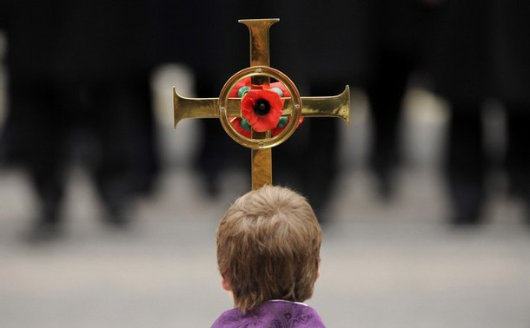Military
About Andrew Cusack
 Writer, web designer, etc.; born in New York; educated in Argentina, Scotland, and South Africa; now based in London.
Writer, web designer, etc.; born in New York; educated in Argentina, Scotland, and South Africa; now based in London. read more
News
Blogs
Reviews & Periodicals
Arts & Design
World
France
Mitteleuropa
Knickerbockers
Argentina
The Levant
Africa
Cape of Good Hope
Netherlands
Scandinavia
Québec
India
Muscovy
Germany
Academica
The Band-leader & the Sergeant-Major
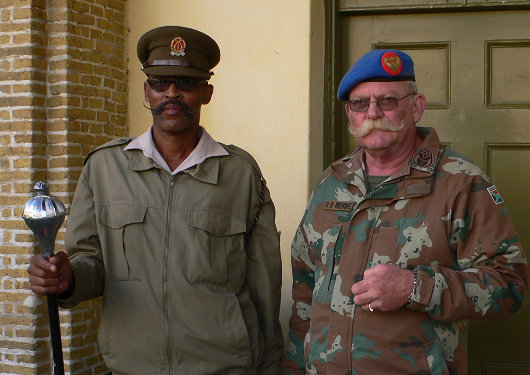
I came across these two characters in the Castle in Cape Town, the oldest building in South Africa and still home to the Cape Town Highlanders and Cape Garrison Artillery.
Victory Day in Moscow
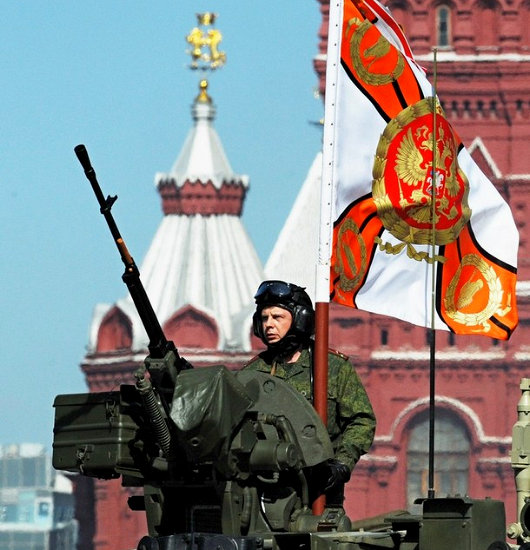
I recently discovered that we receive the television channel Russia Today in our humble little flat here in Stellenbosch, and have spent the past few days enjoying it. They are shockingly truthful (almost nasty) in their reporting of international relations, in so far as the truth — for the moment — tends to favour the Russian case in world affairs, and make NATO look like a bunch of ninnies. Saturday — May 9 — was Victory Day in Russia, in which the defeat of Nazi Germany in the Second World War is commemorated and celebrated. RT showed many minutes of splendid highlights from the great parade in Red Square, and I just sat and enjoyed it.
Old Guard Ball, 1949
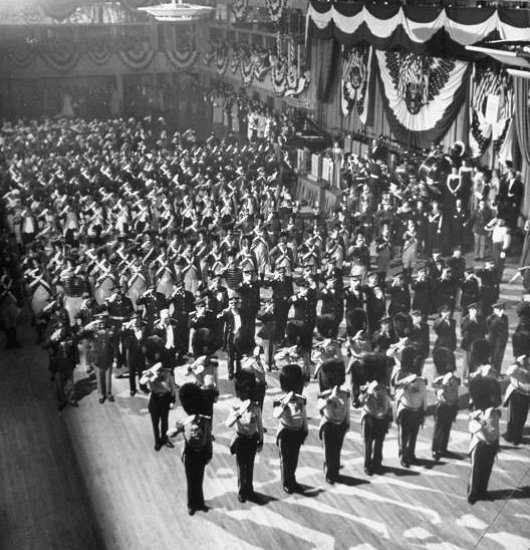
The Annual Ball of the Old Guard of the City of New York, Commodore Hotel, 1949.
200 Years was an Empty Anniversary for New York’s ‘Gallant Seventh’
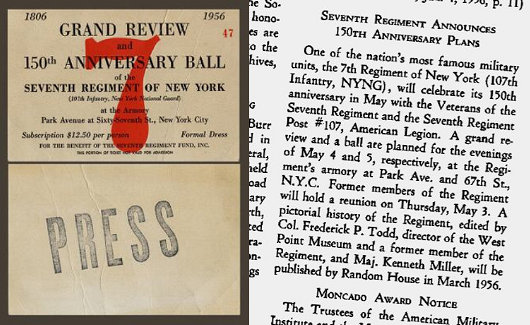
Flipping through a military journal from early 1956, I stumbled upon a rather depressing note announcing the Seventh Regiment’s plans for celebrating its 150th anniversary. A reunion of old comrades on Thursday May 3, then a grand review the following day, and topped off by a formal ball on the evening of Saturday May 5 at the regiment’s beautiful armory on Park Avenue at 67th Street.
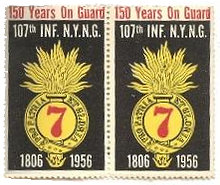 Why should such a splendid celebration spark dour thoughts? Chiefly because, having survived over a century and a half since the unit was founded amidst pints of ale in the Shakespeare Tavern on the corner of Nassau and Fulton, the Seventh Regiment was abolished before it could celebrate its 200th anniversary in 2006. The Seventh was deactivated as a regiment in 1993, though its “lineage” was transferred to the 107th Corps Support Group, which in 2006 was “consolidated” into the 53rd Army Liaison Team. The regiment’s unique collection of historical artifacts — the legal property of the Veterans of the Seventh Regiment — was seized by the State in an act of highly dubious constitutionality and its armory, built without a cent of public money from the pockets of the regiment’s members in the 1880s, was also taken and transferred to a conservancy to run it as an events & performing arts venue, over protests from both veterans groups and the local community.
Why should such a splendid celebration spark dour thoughts? Chiefly because, having survived over a century and a half since the unit was founded amidst pints of ale in the Shakespeare Tavern on the corner of Nassau and Fulton, the Seventh Regiment was abolished before it could celebrate its 200th anniversary in 2006. The Seventh was deactivated as a regiment in 1993, though its “lineage” was transferred to the 107th Corps Support Group, which in 2006 was “consolidated” into the 53rd Army Liaison Team. The regiment’s unique collection of historical artifacts — the legal property of the Veterans of the Seventh Regiment — was seized by the State in an act of highly dubious constitutionality and its armory, built without a cent of public money from the pockets of the regiment’s members in the 1880s, was also taken and transferred to a conservancy to run it as an events & performing arts venue, over protests from both veterans groups and the local community.
First Troop, Philadelphia City Cavalry
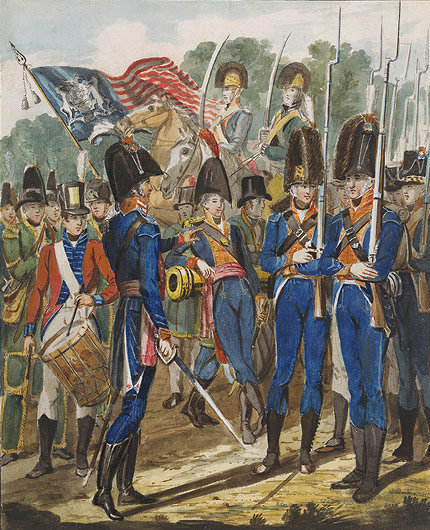
Watercolor, gouache, and graphite on white laid paper, 9 in. x 7 1/4 in.
c. 1811-1813, Rogers Fund
Previously: The Prince of Wales in Philadelphia
Remembering the Seventh
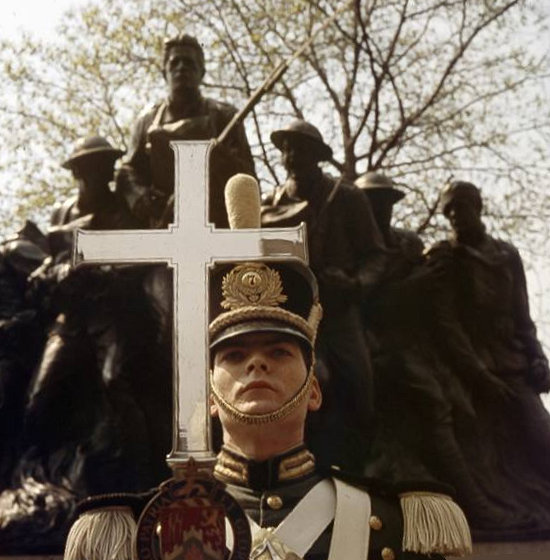
It is entirely appropriate that November 11 — Armistice Day — both falls during the month of the Holy Souls and on the feast of St. Martin of Tours. It’s not unlikely that the souls in Purgatory added their voices to plead for peace that November of 1918, and St. Martin, who had himself been a Roman soldier, was no doubt leading the cause from Heaven. (Indeed, his father having been in the Imperial Horse Guards, St. Martin was born into a military family).
The South African Fleet Review
Africa’s oldest navy parades its newest frigates
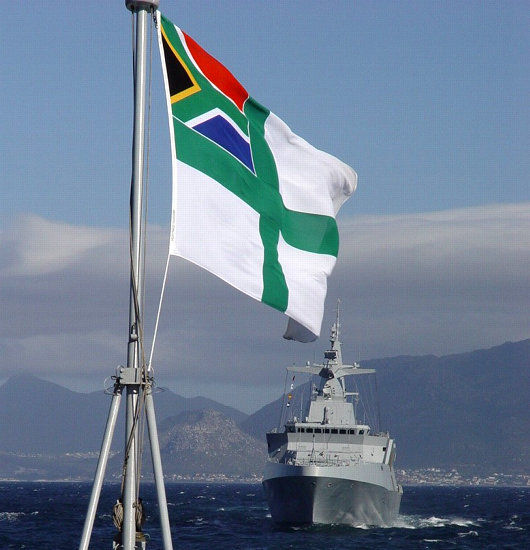
Fleet reviews are not very common occurrences. According to legend, the first fleet review took place when King Henry VIII on a whim gave the order to assemble his navy’s ships as he wanted “to see the fleet together”. On that occasion, the omnivorous monarch was rowed from vessel to vessel and enjoyed a repast on each. The tradition of the monarch reviewing the fleet continued, and usually took place to commemorate the coronation, to welcome a visiting monarch, or to commemorate some other event or occasion of great import.
Since the time of George III, British fleet reviews have typically taken place at Spithead between Portsmouth and the Isle of Wight. The 1814 review celebrating the Treaty of Paris was the last to be composed of only sailing ships, and included fifteen ships of the line and thirty-one frigates: “the tremendous naval armaments which has swept from the ocean the fleets of France and Spain and secured to Britain the domain of the sea”. The 1937 Coronation Fleet Review was made famous by the BBC radio commentary given by Lieutenant-Commander Thomas Woodrooffe. The retired naval officer had met up with a number of chums from his more sea-worthy days in a pub before the broadcast. Woodrooffe’s commentary was so incoherent that he was taken off the air within a couple of minutes; as the fleet was specially illuminated in the evening, Lt.-Cdr. Woodrooffe continually repeated “the Fleet’s lit up”; “lit up” also being a euphemism at the time for being drunk.
A Colonel Inspects His Regiment
Nils Olav and the King of Norway’s Guards
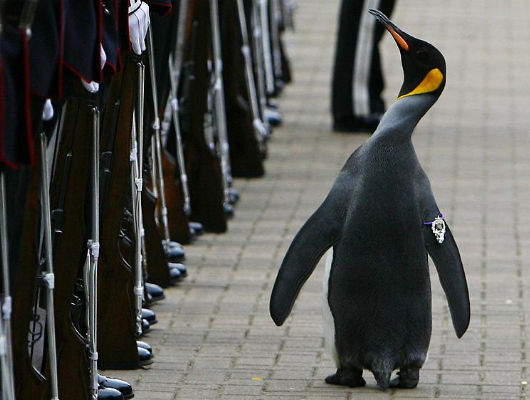
The King of Norway’s Guards is the household regiment of that Scandinavian sovereign, but their honorary colonel resides in Edinburgh, where the regimental band often performs in the famous Military Tattoo held each summer. This year, the Colonel was honored with no less than a knighthood and took the opportunity of the unit’s presence in Edinburgh to inspect the regiment. Ordinarily, this would be an unremarkable event were it not for the fact that the Colonel is Nils Olav, a penguin currently in residence at the Edinburgh Zoo.
What was that you were saying about “cheese-eating surrender monkeys”?
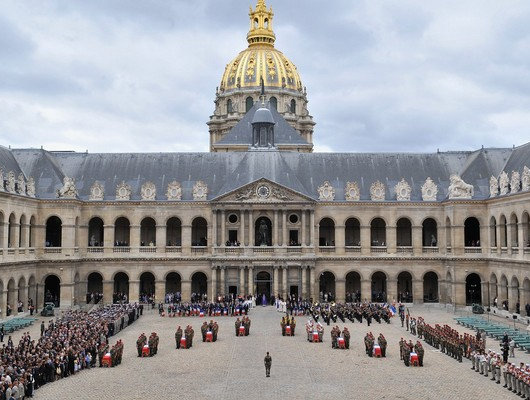
Yann Baly writes:
“Regarding the sacrifice of the 10 young French soldiers killed in combat in Afghanistan, we have heard many voices, including those of the families of the young parachutists, saying that they died for nothing.
“Politicians are duty-bound to question the timeliness of our engagement in Afghanistan under NATO command, in a war desired by the United States. We cannot remain silent when France, and French youth have, in the past, paid too heavy a price because of “sacred” unions in wars that diplomacy and sensible politics could have avoided.
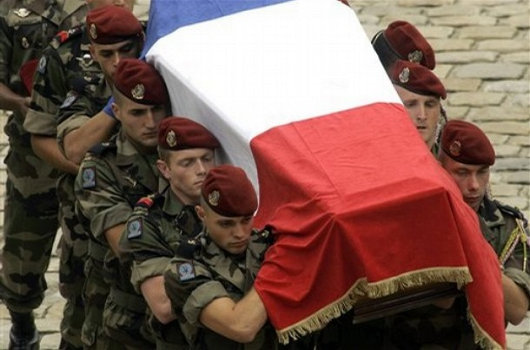
“Yesterday, in the majestic courtyard of les Invalides, the French people were able to recall that certain political errors are paid for in blood. It is therefore legitimate to wonder if Jacques Chirac (who was not present yesterday) and Lionel Jospin were right to send the French army into Afghanistan in 2001 and if Nicolas Sarkozy was not wrong to reenforce the contingent with the inadequate means we are all aware of. As Bernard Antony has reminded us, the United States has committed so many errors of foreign policy, so many criminal mistakes in its diplomatic and military actions, that one can doubt the need to be present in Afghanistan. History shows us that economic and oil interests have often been a decisive element in the American involvement in military conflicts. Fight efficiently against terrorism? There too, there are questions to be asked.
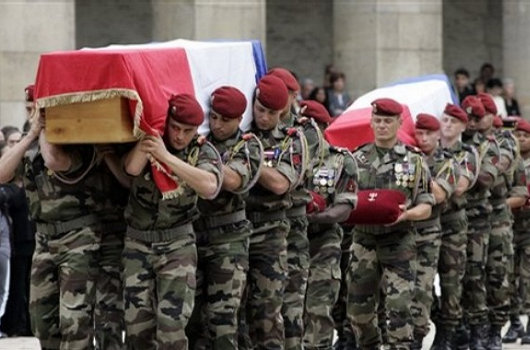
“Nonetheless, it is false to say that our young parachutists died for nothing. First of all, the French people have become conscious once again that they had an army. A month and a half after the tragedy in Carcassonne, the blood of these soldiers has washed away the lies, insults and spite, some of it coming from the head of State himself, heaped on the French army. But most of all, in our society where egoism and individualism are the rule, for a people who seem to have forgotten the meaning of sacrifice, their death in combat, at the age of 20 for most of them, is no doubt a sign of an imminent resurrection of the spirit of French resistance. In the current international and national context, this dimension is not insignificant. France, like the rest of the world, is entering into a period of uncertainties and grave risks. To be conscious of that and to prepare for it is not nothing.”
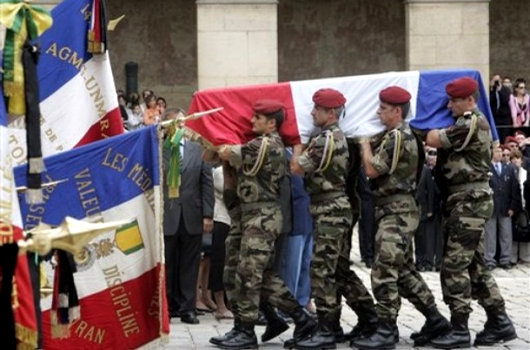
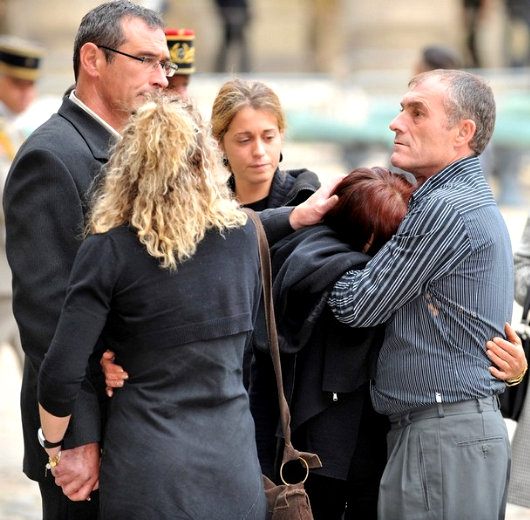
The Pope at Government House

Pope Benedict XVI reviews the guard after being received by Maj. Gen. Jeffery, the Governor-General of Australia.
The Annual Inspection

The ceremonial Changing of the Guard takes place at Rideau Hall, Canada’s viceregal palace, and Parliament Hill during the warmer months of the year. I recall with great fondness a summer trip to Ottawa when I was but a little boy and watching the Changing of the Guard on the green in front of the splendidly gothic parliament buildings. I instantly wanted to become a Canadian soldier, and pondered how many chocolate bars I could hide in the bearskin cap of a red-tunic’d guardsman. (Needless to say, I have not become a Canadian soldier, but Sa Majesté need only call and I would be at her service).
Catholics & the Military
Back in May, Michael J. Iafrate, a fellow Catholic who is a native of the great state of West Virginia and is now studying in the fair dominion of Canada, raised the subject of the obnoxious proselytism by Evangelical Protestants in our nation’s military on his very interesting site, catholicanarchy.org.
Mr. Iafrate commented:
To be fair, the early Christians were forbidden to serve in the Roman military because it typically involved making occasional sacrifices to pagan gods, not because of an objection to the military service itself. Indeed, we have early saints such as St. Maurice (pictured at left in a painting by Lucas Cranach the Elder), a Catholic African who served in the Roman military, and of course St. Alban as well.
 The story of Spc. Hall that Mr. Iafrate brings our attention to is not really about the “problem” of Christians in the military but rather one of the problems of Evangelical Protestant Christianity in general, exhibited in the specific situation of the military in particular. Many Evangelical Protestants know no form of evangelization other than the full frontal attack. I’m sure we’ve all had our fair share of run-ins with the “HaveyouacceptedJesusChristasyourLordandSavior?” type.
The story of Spc. Hall that Mr. Iafrate brings our attention to is not really about the “problem” of Christians in the military but rather one of the problems of Evangelical Protestant Christianity in general, exhibited in the specific situation of the military in particular. Many Evangelical Protestants know no form of evangelization other than the full frontal attack. I’m sure we’ve all had our fair share of run-ins with the “HaveyouacceptedJesusChristasyourLordandSavior?” type.
Catholics, meanwhile, are a bit lackluster in the realm in-your-face evangelization (and I’m not sure this is regrettable because I think a great many souls turn away from Christianity because Evangelical Protestantism is the only form they are familiar with). Why not, we would say, try 1) setting an example by leading a virtuous Christian life, 2) praying for those you hope God will convert, or 3) fasting, making little sacrifices, or offering up little sufferings?
Historically, we Catholics have also preferred evangelizing through institutions, such as monarchies or universities or hospitals and other works of charity and mercy. Many a tribe and nation were converted by zealous souls going and converting their king or ruler first. Modern-day types will probably decry this as “elitist” — the Jesuit Fr. Reese, of America magazine notoriety, scandalously suggested that we shouldn’t be proud of an Emperor-Saint like Charles of Austria because it’s “elitist” and “not the kind of message we should be sending”. While Fr. Reese might be keen on abandoning the souls of the powerful and having godless un-Christian people running the world, I think most Catholics would prefer holy people to be in positions of power, and for people in positions of power to be holy.
I, for one, wish that traditional apostolic Christians (i.e. Catholics & Orthodox) would serve in the military in droves. I would feel much more comfortable were our armed forces heavily dominated by Catholics and Orthodox Christians than merely left to atheists, evangelical Christians, and run-of-the-mill materialists.
The fact that Spain ‘s military was so Catholic-dominated in the 1930’s saved the country from the Communists. (Though, admittedly, the Spanish Communists were so horrendous that the military junta even had a unbelieving Freemason among its members!). At the end of the Spanish Civil War, Franco laid his sword upon the altar of the Church of St. Barbara in Madrid, praying “Lord, benevolently accept the effort of this people, which was always Thine, which, with me and in Thy name, has vanquished with heroism the enemy of Truth in this century.” He then vowed never again to take up that sword unless Spain herself was threatened, and kept that vow til his death.
And then one thinks of anti-Nazi officers in the German army like Stauffenberg and Boeselager. One of the most faithful defenders of the (non-Catholic) Hawaiian monarchy against its American capitalist foes was a Catholic officer in the Hawaiian army. I certainly find it comforting that nearly half the officer corps of the British Army are Catholic.
UPDATE: Mr. Iafrate responds, both below and here.
The Royal Military College of St. John

WHAT BETTER WAY to celebrate this, the feast of St. John the Baptist and the national day of Quebec, than to bring you news of the reëstablishment of the Collège militaire royal de Saint-Jean. The site in the town of Saint-Jean-sur-Richelieu was first put to a military use in 1666 when the French soldiers of the Carignan-Salières Regiment. The Collège militaire royal, however, was only founded in 1952 when it was inaugurated by the Rt. Hon. Vincent Massey, CC, CH, GCStJ, CD, PC as a classical college to increase the number of French-speaking officers in the Army, the Royal Canadian Navy, and the Royal Canadian Air Force.
Los Patricios – The Patricians

In my carelessness last week, I mistakenly wrote that the presidential guard in Buenos Aires are the “Patricios” regiment, when (as Cruz y Fierro corrected me) it is actually the Regiment of Horse Grenadiers. The First Regiment of Infantry “Patricios” (literally “Patricians”) is the oldest regiment in the Argentine Army and predates by ten years the country’s Declaration of Independence. It was first assembled as the “Legion of Volunteer Urban Patricians” in 1806 to repel the English invasions of that year.
In these two photos you can see the “Patricios” performing the somewhat-rare ceremony of the changing of the guard at the Cabildo, across the Plaza de Mayo from the Casa Rosada.

andrewcusack.com: Argentina
Changing the Guard in Buenos Aires

The changing of the guard at Government House, Buenos Aires, the Presidential Palace of the Argentine Republic more popularly known as the ‘Casa Rosada’ due to its pink hue.
The Patricios regiment who provide the presidential escort were founded in 1806, making them as old as New York’s 7th Regiment. (Unlike the 7th, however, Los Patricios not only still exist but indeed flourish as the oldest regiment in the Argentine Army).
UPDATE: Cruz y Fierro corrects me that the presidential guard are formed by the Regiment of Horse Grenadiers, not Los Patricios. I have often confused the two in the past, I must admit.

andrewcusack.com: Argentina
St. George Guards India’s Fleet Once More
In a return to tradition, the old Indian naval ensign is reinstated.

AFTER AN EXPERIMENT with an allegedly more ‘indigenous’ design, India’s traditional naval ensign has been restored, and so the Cross of St George once again snaps from the sterns of the Union’s warships. The old Indian Naval Ensign dated to 1950, when the Indian Union became a republic, three years after achieving dominion status as a wholly self-governing member of the British Commonwealth. The Royal Indian Navy had flown the unaltered White Ensign but with the changeover to a republic it was decided to simply exchange the Union jack in the canton with the national flag of India, retaining the red St. George’s cross on a white field. (more…)
The Knickerbocker Greys
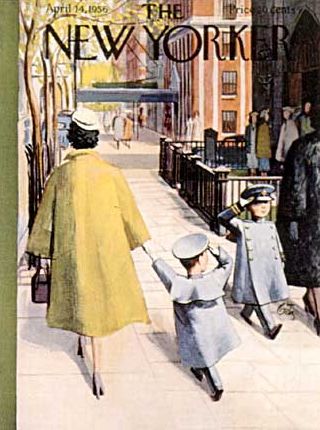
The Knickerbocker Greys, the Upper East Side corps of cadets, is celebrating its 125th year in existence. Both the Times and the Sun have featured articles on the Greys:
‘Celebrating 125 With the Knickerbocker Greys‘ by Gary Shapiro (The New York Sun)
‘Manhattan’s Littlest Soldiers‘ by Eric Königsberg (The New York Times)
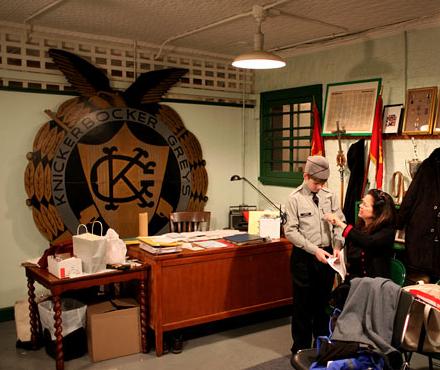
Above: A mother mends a cadet’s uniform.
Below: Cadets assembled in an Armory corridor. (Note the interior scaffolding due to the State’s grievous neglect of the Armory).
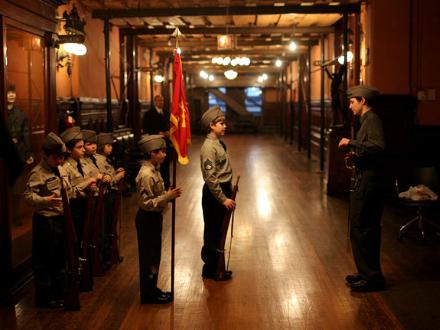
Governors Island Revisited
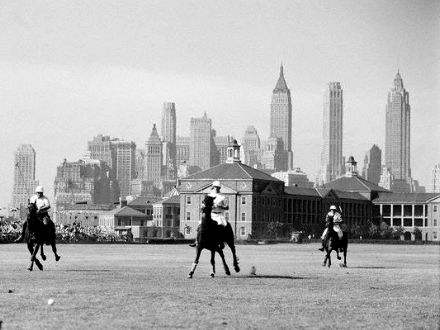
EVERY ONE OF THE myriad plans put forth for the ‘redevelopment’ of the venerable old Governors Island in New York Harbor has so far either stalled, been neglected, or otherwise poo-pooed. In this, we have something to rejoice. As I have often said, realistically speaking there is little that can be done to it which will not neglect or disgrace the island’s long military heritage. The officially-approved ideas put forth so far have been horrific: an amusement park, a casino, a ‘technology park’, as well as a number of other vapid proposals.
Naturally, we’d be enthused if it returned to its former role as swankiest post in the entire Army and the home of Army polo, but don’t hold your breath. West Point being the single exception, if it has even a touch of history, tradition, or class, Congress and the Department of Defense will do their best to get rid of it. After all, the National Guard has been pulled out of the Seventh Regiment Armory, the Navy has withdrawn all but a few institutions from Newport, and the Army has left the ancient Presidio of San Francisco; how long will it be until Fort Leavenworth’s foxhounds are brought out back and shot by the Monotony Monitors? (more…)
Old Guard on Governors Island

A photo of the Old Guard of the City of New York on Governors Island, with Manhattan in the background, taken on St. George’s Day, 1933. [Click here for larger photo]
Previously: Evacuation Day | Marshal Foch and the Old Guard | A New York Funeral | Old Guardsmen | The Old Guard | Grandpa
Category: New York Militaria
Search
Instagram: @andcusack
Click here for my Instagram photos.Most Recent Posts
- Waarburg October 2, 2024
- A Prize for the General September 23, 2024
- Articles of Note: 17 September 2024 September 17, 2024
- Equality September 16, 2024
- Rough Notes of Kinderhook September 13, 2024
Most Recent Comments
Book Wishlist
Monthly Archives
Categories

